Woolly Clover
trifolium tomentosum
Also known as: ["Matted Clover","Velvet Clover"]
Overview
A low-growing, creeping perennial clover with soft, velvety leaves and small white flowers.
Benefits & Perks
["wildlife attractant (bees, butterflies, birds)","drought tolerant","ground cover"]
Botanical Classification
| Phylum: | Magnoliophyta |
| Class: | Magnoliopsida |
| Order: | Fabales |
| Family: | Fabaceae |
| Genus: | Trifolium |
| Botanical Name: | Trifolium tomentosum |
Plant Characteristics
Basic Information
- Category: Flowers
- Suitable Location: ground cover in garden beds or containers in temperate climates
- Suitable For:
- Is Weed: No
- Allergenicity: low
Environmental Needs
- Climate: {"temperatureRange":"5–30°C"}
- Hardiness: {"zones":"6–9"}
- Misting: rarely required, only if ambient humidity is very low
- Drainage: Fast-draining to prevent waterlogging.
- Soil Type: Well-draining, loamy soil with some organic matter; can tolerate sandy or chalky soils.
Maintenance Level
- Maintenance Level: low
- Toughness Level: moderate
- Pruning Frequency: Light pruning every 2–3 months; major pruning annually after flowering or in early spring.
- Pruning Intensity: Moderate; remove up to one-third of growth for rejuvenation pruning.
Care Details
Ideal Sunlight Coverage:
Bright indirect light for 6–8 hours daily; can tolerate partial shade, especially in hot climates.
Sunlight Tolerance Tips:
Acclimate plants gradually to direct sun; protect from intense midday sun to prevent scorching; adjust placement based on seasonal light changes.
Care Requirements
Care Difficulty
easymoderate
Sunlight
full sun to partial shade
Rotate plant weekly for even growth; use sheer curtains to filter intense light; move outdoors in spring/summer for stronger light.
Watering
every 7–10 days during active growth, reduce in winter
Water thoroughly but infrequently; ensure good drainage; avoid wetting foliage to prevent fungal diseases.
Soil
well-draining, sandy loam with moderate organic matter
pH: Slightly acidic to neutral (pH 6.0–7.0).
Use a mix of potting soil and perlite; avoid heavy clay soils; ensure pots have drainage holes.
Temperature
Prefers moderate temperatures (60–75°F or 15–24°C); tolerates cooler conditions but avoids frost.
Avoid placing near drafty windows or heat vents; maintain consistent temperatures; adjust care based on seasonal changes.
Fertilizing
every 4–6 weeks during spring and summer
Apply fertilizer after watering to prevent root burn; flush soil occasionally to prevent salt buildup; reduce feeding in dormant periods.
Propagation
Methods
Stem cuttings or division; stem cuttings are more common for home growers.
Step-by-Step Propagation Guide
- Take a 4–6 inch cutting.
- Remove lower leaves.
- Dip in rooting hormone (optional).
- Plant in moist medium.
- Keep warm and humid.
Best Time: Spring or early summer when the plant is actively growing.
Environment
Warm, humid environment with indirect light; maintain consistent moisture.
Medium
Well-draining potting mix with perlite or sand; can also root in water initially.
Hormone
Rooting hormone is optional but can improve success rates.
Timeline
Roots typically form in 2–4 weeks; new growth may appear in 4–6 weeks.
Tools Needed
Pruning shears, rooting hormone, small pots, well-draining mix.
Quick Tips
Use healthy, non-flowering stems; maintain high humidity with a plastic cover; keep out of direct sun.
Pruning & Repotting
Pruning Guide
Method
Pinch back tips for bushier growth; cut just above a leaf node or bud.
Pruning Plan
Prune to maintain shape, encourage bushiness, and remove dead or leggy growth.
Tools
Clean, sharp pruning shears or scissors.
Checklist
Sanitize tools; prune dead or damaged stems; shape as desired; dispose of clippings properly.
Repotting Guide
Best Season
Spring, before the active growing season begins.
Pot Size
Increase pot size by 1–2 inches in diameter; avoid oversized pots.
Method
Remove plant gently; trim any circling roots; place in a slightly larger pot with fresh, well-draining soil; water thoroughly.
Suggestions
Repot every 1–2 years or when roots fill the pot; beneficial for growth and soil freshness.
Checklist
Choose appropriate pot; prepare fresh soil mix; handle roots carefully; water after repotting.
Advanced Care Tips
Watering Mastery
Watering Checklist
Check soil moisture; water deeply; ensure drainage; avoid wetting leaves.
How to Apply Water Properly
Water at the base of the plant, ensuring moisture reaches the root zone; allow excess water to drain away; water in the morning to reduce evaporation and fungal risk.
Watering Schedule Tips
Water deeply once the top inch of soil feels dry; reduce frequency in winter to prevent root rot.
Soil Improvement
Add perlite or sand for drainage; incorporate compost for fertility; ensure soil is loose and airy.
Temperature Stress Management
Signs of Temperature Issues
Wilting, yellowing leaves, or stunted growth in extreme heat; leaf drop or browning in cold stress.
Cold Stress
Low temperatures slow growth and can cause leaf damage or dieback; frost can be lethal.
Solution: Protect from frost with a cover or move indoors; ensure good air circulation to prevent mold in cool conditions.
Hot Stress
Excessive heat can lead to wilting, leaf scorch, or reduced flowering; may require increased watering.
Solution: Provide shade during peak heat; increase humidity with misting; water more frequently but avoid waterlogging.
Fertilizing Guide
Fertilizing Checklist
Check fertilizer strength; apply during active growth; avoid winter feeding; flush soil periodically.
Fertilizing Method
Use a balanced liquid fertilizer diluted to half strength every 4–6 weeks during growing season (spring/summer); avoid fertilizing in winter.
Common Problems & Solutions
Toxicity Warning
Cats
Non-toxicTrifolium tomentosum is not toxic to cats. The plant does not produce any known toxins that would harm felines.
🌿 Toxic Parts:
⚡ Toxic If:
if eaten
Dogs
Non-toxicTrifolium tomentosum is not toxic to dogs. There are no documented cases of adverse effects from ingestion by canines.
🌿 Toxic Parts:
⚡ Toxic If:
if eaten
Humans
Non-toxicTrifolium tomentosum, commonly known as woolly clover, is not considered toxic to humans. It has no known adverse physiological effects when ingested in typical quantities.
🌿 Toxic Parts:
⚡ Toxic If:
if eaten
Frequently Asked Questions
Q: Is Woolly Clover suitable for ground cover?
A: Yes, its creeping growth habit makes it an excellent ground cover plant.
Q: Does Trifolium tomentosum attract pollinators?
A: Yes, it attracts bees, butterflies, and other pollinators with its small white flowers.
Q: How should Woolly Clover be watered?
A: Water moderately, allowing the soil to dry slightly between waterings; it is drought-tolerant once established.
Quick Reference
| Family: | Fabaceae |
| Care: | easy |
| Light: | full sun to partial shade |
| Water: | every 7–10 days during activ |
Get Expert Care Tips
Download the Plantious app for personalized care reminders and plant identification!
Google Play App Store







